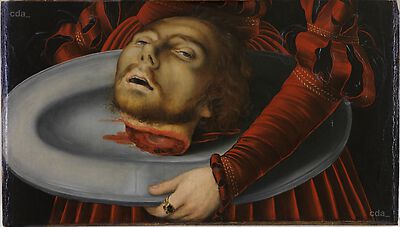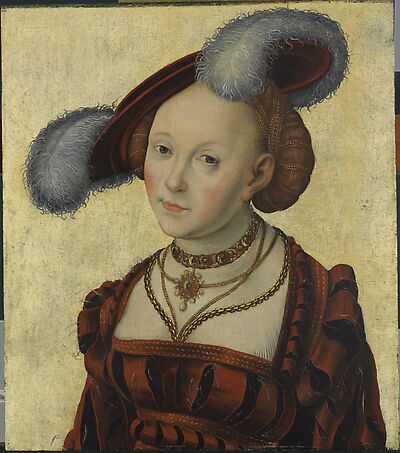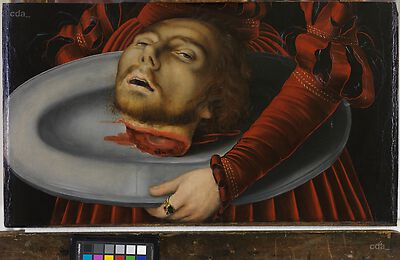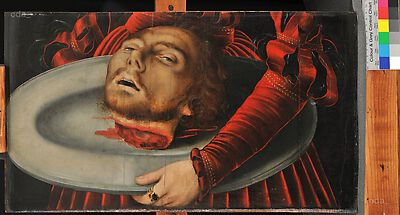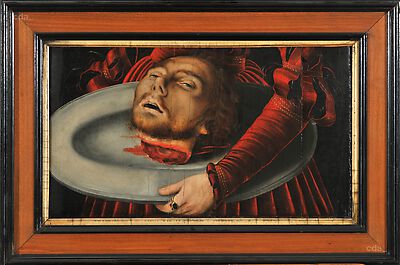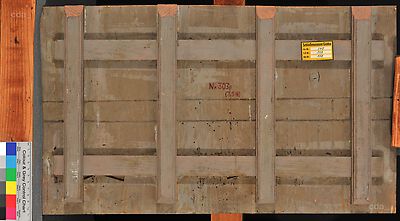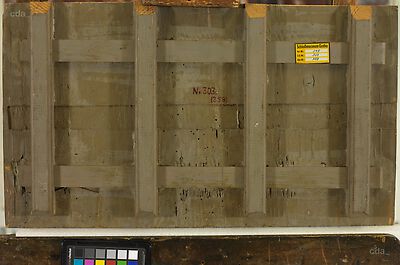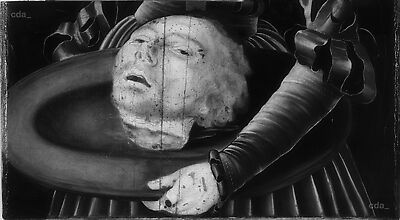In various biblical depictions from the 16th century the tragedy of St John the Baptist was used to illustrate the transgression of a ruler, tyranny and catholic idolatry. [1] This usurpation of the biblical story, in particular from a protestant perspective, is especially noticeable with regards the ernestine elector, who identified himself with St John the Baptist. His unwavering belief, which led to his imprisonment and martyrdom offered a welcome parallel to the fate of Elector Johann Friedrich the Magnanimous of Saxony. He had adopted the first professor to Christianity as his patron saint. Johann Friedrich who was taken prisoner while fighting for the protestant faith against the catholic emperor was condemned to death in 1547. This sentence was changed to life imprisonment upon the intervention on his part by influential princes. A connection between Johann Friedrich's life and his martyrdom for his beliefs is also established in the commemorative text on his death in 1554. [2]
Similar to the image in Gotha is a painting in Budapest (about 1526/30), which also shows Salome against a dark background and divorced of a narrative context . [3] The luminous red, slitted dress differs in numerous details, but exhibits a similar arrangement of the folds. Instead of a feathered hat Salome wears a bride's wreath in her hair. Various female half-length figures quote the upper section of the Gotha panel, but do not compare in painterly quality and can be attributed to the circle or followers of Cranach. [4] In addition a faithful copy of the painting by Christian Richter (about 1640/50) is preserved in Braunschweig and documents the long-lasting interest in Cranach's pictorial invention. [5] According to Schade the work in Gotha can be attributed to a follower of Cranach and was created about 1600. However, the style and painterly quality of the panel confirmed by the recent conservation treatment (2014/15) as well as the numerous copies make it worth while to question this attribution and the late dating. [6] An earlier dating is supported by the original dimensions of the panel that correspond to one of the preferred standard sizes employed in the Cranach workshop between c. 1520 and c. 1535, and the suppport material (fir wood), which was frequently used in the second decade of the 16th century.[7] The date uncovered on the upper section during a dubious restoration does not help in answering the question regarding the date of creation. [8] In 1972 the dark background was considered not authentic and removed. This intervention took into account a considerable loss of original paint along the contours. The portrait of Salome now appears against an odd, patchy light backdrop, that appears very uncharacteristic for Cranach. The Cranach insignia and date '1549' was apparently uncovered to the right of the head during this treatment. Recent technical examination of the lower section can now prove without doubt that this panel never had a white background and that this is the light ground and therefore the authenticity of the uncovered inscription must also be questioned.
The painting of Salome in Gotha is from ernestine property and arrived as a dowery from Duchess Sophie of Saxony-Altenburg (1619-1680) from Altenburg in Gotha, where it is first recorded in1644. [9] Such a prominent provenance speaks in favour of a new evaluation of the panel.
[1] Washof 2007, 331
[2] Exhib. Cat. Gotha 1994, 162, No. 2.49
[3] Cranach the Elder, about 1526/30, Szépmüvészeti Múzeum, Inv. No. 145, see Exhib. Cat. Brussels 2010, 213, No. 115
[4] Cranach follower, 'Female Half-length Figure with a Feathered Hat,' oil on wood, 62 x 52.5 cm, whereabouts unknown (Dorotheum 2010); Monogrammist HVK, 'Female Half-length Figure with a Feathered Hat,' oil on wood, 23 x 19.2 cm, whereabouts unknown (Koller 2007); Cranach follower, 'Female Half-length Figure with a Feathered Hat,' 17th century, 58.5 x 51.5 cm, whereabouts unknown (Boisgirard Antonini, Paris, 13. August 2006); Cranach workshop, 'Female Half-length Figure with a Feathered Hat', 16th century, Staatsgalerie im Schloss Johannisburg, Aschaffenburg; Cranach workshop, 'Female Half-length Figure with a Feathered Hat', oil on wood, 57 x 50 cm, Louisville (Kentucky), Speed Art Museum.
[5] Christian Richter, Salome with the Head of St John the Baptist, Herzog Anton Ulrich-Museum, Braunschweig. See Jacoby 2002, 206 ff.
[6] The conservation treatment was generously financed by the Freundeskreis Kunstsammlungen Schloss Friedenstein Gotha e. V.
[7] Heydenreich 2007, 43 and 47 f.
[8] Jacoby 2002, 209
[9] Exhib. Cat. Gotha 2001, 49.1
